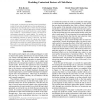Free Online Productivity Tools
i2Speak
i2Symbol
i2OCR
iTex2Img
iWeb2Print
iWeb2Shot
i2Type
iPdf2Split
iPdf2Merge
i2Bopomofo
i2Arabic
i2Style
i2Image
i2PDF
iLatex2Rtf
Sci2ools
AAAI
2007
2007
Modeling Contextual Factors of Click Rates
In this paper, we develop and evaluate several probabilistic models of user click-through behavior that are appropriate for modeling the click-through rates of items that are presented to the user in a list. Potential applications include modeling the click-through rates of search results from a search engine, items ranked by a recommendation system, and search advertisements returned by a search engine. Our models capture contextual factors related to the presentation as well as the underlying relevance or quality of the item. We focus on two types of contextual factors for a given item; the positional context of the item and the quality of the other results. We evaluate our models on a search advertising dataset from Microsoft’s Live search engine and demonstrate that modeling contextual factors improves the accuracy of click-through models.
| Added | 02 Oct 2010 |
| Updated | 02 Oct 2010 |
| Type | Conference |
| Year | 2007 |
| Where | AAAI |
| Authors | Hila Becker, Christopher Meek, David Maxwell Chickering |
Comments (0)

